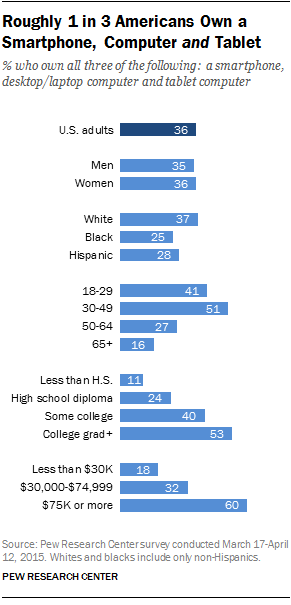As the world grows increasingly digital, choices abound for ways to tap into it. And for many Americans, one device isn’t enough.

A new Pew Research Center analysis finds that 66% of Americans own at least two digital devices – smartphone, desktop or laptop computer, or tablet – and 36% own all three.
Fueled in part by the rapid adoption of smartphones and tablets, the share of American adults who own a smartphone, computer and a tablet has doubled since 2012. At that time, only 15% of U.S. adults owned all three devices.
The age group most likely to own multiple devices is 30- to 49-year-olds, half of whom report owning all three, according to our 2015 survey data.
People who are more affluent and those with more formal education also are more likely to own multiple devices. Whites are a bit more likely than blacks to have all three gadgets, while men and women are equally likely to do so.
Previous research from Pew Research Center shows that owners of multiple digital devices use the internet more frequently, go online from multiple locations and are especially more likely than others to use the internet while “on the go.” They are also more likely to have profiles on social networks and to manage their online privacy and digital reputations more diligently.
Some 18% of American adults own only one of the three devices. Among single-device owners, 60% say they have a desktop or laptop computer, compared with a third (34%) whose only device is a smartphone, while 7% report their sole device as a tablet. (Smartphones and desktop and laptop computers are among the most commonly owned technology devices overall.)
Although most Americans own at least one device that can help them accomplish a digital task – whether it’s looking for a job, completing a work assignment, getting directions or downloading the latest podcast – a portion of the population has none of these digital tools.
Some 16% of U.S. adults do not have a smartphone, desktop or laptop, or tablet. Demographic differences within this group are mostly consistent with other gaps in technology adoption that Pew Research Center has measured. Income, age, and race and ethnicity are factors, as is educational attainment. For example, among adults who have not completed high school, half do not own any of these devices.
